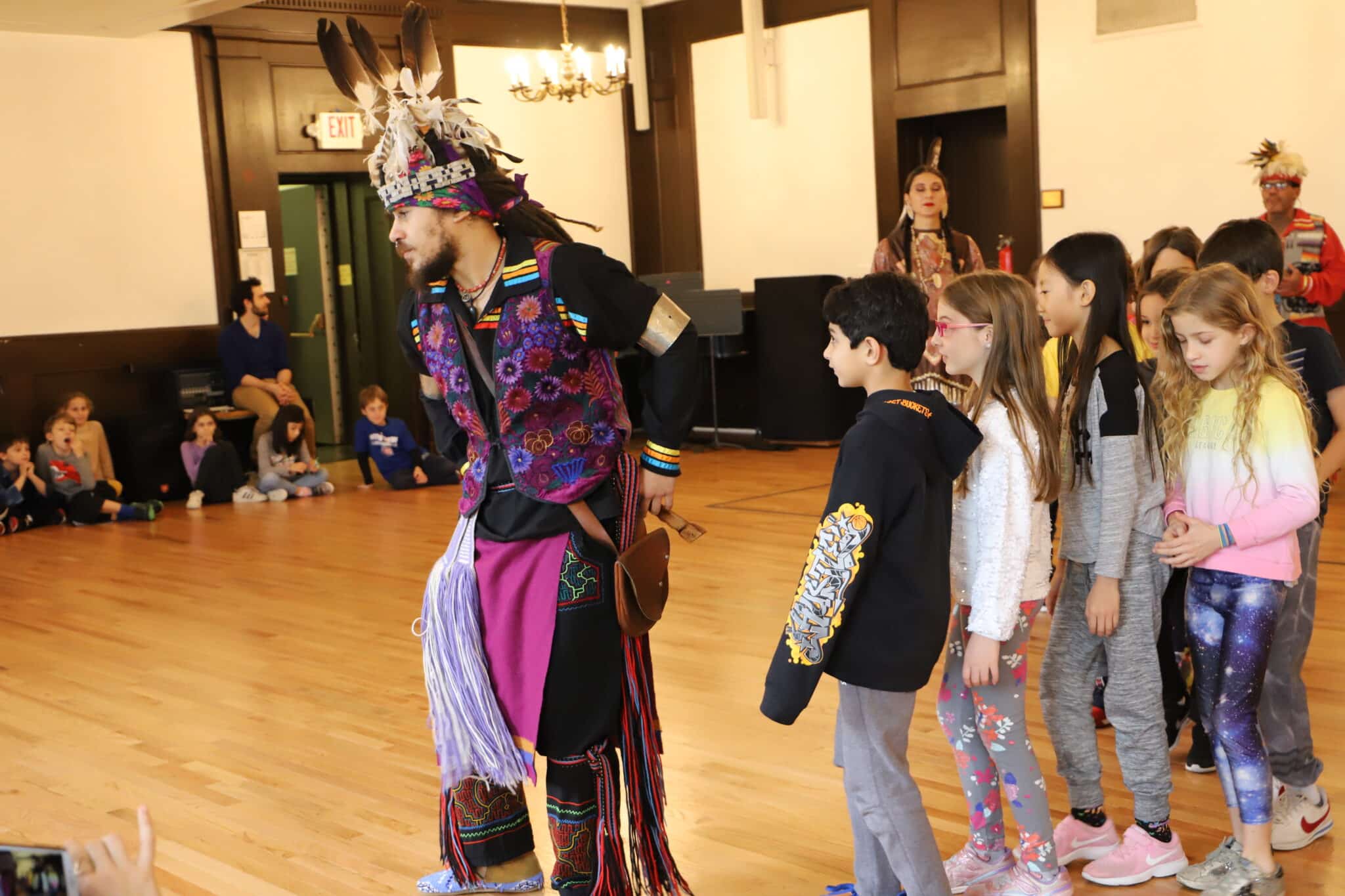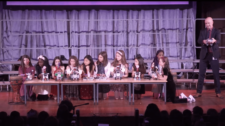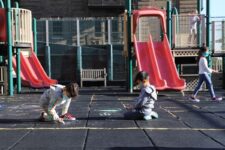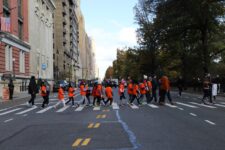On a bright November day, Inwood Hill Park — the last natural forest and salt marsh in all of Manhattan — plays host to Ethical Culture 3rd Graders, who use an “imaginative lens to think about what this island would have looked like 400 years ago, before European influence,” says Social Studies Workshop Teacher Leonard White. It’s a long day: The group leaves Ethical Culture at 9:00am and doesn’t return until 2:00pm. Over the course of the trip, students hike about two miles, stopping to explore caves, identify trees, and build shelters. White leads the students through discussions of natural resources and meeting basic needs — and how Indigenous groups like the Lenape met those needs in sustainable ways.
The annual trip occurs at the beginning of Ethical Culture’s 3rd Grade Indigenous Studies unit, a yearlong exploration of Native American populations. The curriculum dedicates much of its time to a study of the Lenape people, who historically lived in what is now New Jersey, eastern Pennsylvania, New York City, western Long Island, and the Lower Hudson Valley. After a complex history of interactions, treaties, and alliances between the Lenape, Europeans, and the Haudenosaunee, colonial settlers ultimately decimated and expelled much of the population — though many Indigenous people still live in Manhattan today.
The trip forecasts the unit as a whole, which touches on everything from climate change to natural resources to art to sports teams. Like the rest of the year’s work, the goal of the trip is “to ground their work in something that is experiential and connected to the land,” White says. “It’s a way of launching it in a way that’s fun and in a way that’s an experience that’s going to last with them.”
A few years ago, the 3rd Grade team realized the Indigenous Studies unit was due for an overhaul. Previously, instruction focused on the Lenape and the Mannahatta of the distant past, a focus that “kept perpetuating this idea that Lenape people don’t exist today,” says Cara Regan, 3rd Grade Teacher.
Redesigning the curriculum began with an examination of contemporary Native American issues, Regan says. The teachers worked backward from there to restructure the curriculum, pivoting toward a social justice lens.
First, the 3rd Grade team and former Diversity Coordinator Nayantara Mhatre examined the existing curriculum, which culminated in an end-of-year presentation they called a “museum.” They realized that framing the presentation as a museum was harmful, as it reinforced the idea that Native Americans existed purely in the past. Thus, the museum became a “share out,” a presentation of the year’s work that focuses on Indigenous Studies with a more modern and critical lens.

To get to a more holistic look at Indigenous Studies, the 3rd Grade team tackled issues that impact Indigenous populations today: forced movement around the country, access to food, and climate change, to name a few.
“We also try to balance presenting the challenges that Native American communities face today with presenting ways that they’ve found their voice and ways to empower themselves,” says Eliana Rivera, Language and Learning Specialist.
The team updated assignments and activities, bringing them into the present and grounding them in more nuance. “We have to put a more mindful spin on it,” says Yan Davydov, 3rd Grade Teacher.
In previous years, students were divided into groups that focused on specific topics, like pottery, cooking, or clothing. Now the groups are approaching these topics from a contemporary angle. While the pottery group makes crafts in the Lenape tradition, they also focus on natural resources. While the cooking group might have simply made cornbread, they have added a focus on access to food in Indigenous communities. The clothing group formerly made replicas of Native American clothing, but they have now switched their focus to changing sports mascots that are offensive and harmful to Native Americans. When writing creation stories “felt more like appropriation than appreciation,” Davydov says, the assignment morphed into a deep-dive research project about a Native nation.
In the new curriculum, students begin the year learning about community, identity, and social justice. They then segue into in-depth discussions about stereotypes, examining those associated with their own identities before drilling down on those associated with Native Americans. This work is the crux of the study, and the effort to unlearn inherited biases is fierce.
The teaching is deeply interdisciplinary — in the clothing group, for example, students learn persuasive writing and craft letters to sports organizations arguing for a change from racist mascots. In the environmental activist group, students learn about the mechanics of cleaning up an oil spill from a scientific perspective, but also highlight the fact that the “Lenape were really on the front line of bringing attention to the fact that there was a proposed oil pipeline being built underneath the Hudson River,” says Math and Science Teacher Barbara Downing.
“I don’t know if too many other people were in tune with that until the Lenape started speaking out,” she says.
The 3rd Grade team works to center Indigenous voices in their instruction, from watching Teen Vogue video interviews with Native American teens to welcoming the Redhawk Dancers in an in-class workshop. Led by Cliff Matias, the Redhawk Dancers demonstrate various ceremonial and social dances for a rapt 3rd Grade audience and invite the students to learn the intricate steps.
Exposure to current Native American voices is critical, and students learn firsthand just how relevant their unit is. Take for example, a question posed by a student to Matias: “Where did they do the dances?” Matias corrects the misconception: These dances — and Native American cultures — are still very much in existence today.
Students enter the yearlong study with varying degrees of understanding about issues affecting Native American populations, says 3rd Grade Teacher Kate Culligan, and that understanding is dependent on their own experiences and identities and on what conversations have happened at home or in school. But by the end of the year, the students are united in their zeal: “The majority of our kids left feeling like they wanted to do something to make it better,” Culligan says. “Our kids work to become allies and advocates for the Native population.”
At the share out, for example, the student presentations of their redesigned sports jerseys ask visitors to write letters to sports teams, urging viewers to “do some action rather than just looking at exhibits,” Regan says.
There’s power in kids teaching other kids.
Engaging with a topic in such an in-depth manner clearly makes the learning stick. When the 1st Grade teachers wanted to center more Indigenous voices around their Harvest Festival, Ethical Culture Diversity, Equity, and Inclusion Coordinator Vanessa D’Egidio enlisted last year’s 3rd Graders to put together a mini-lesson, culling from what they’d learned the year before. “There’s power in kids teaching other kids,” D’Egidio says, and when she asked the current 4th Graders to volunteer, the result was overwhelming. The students were so dedicated to spreading their knowledge that they requested that D’Egidio host “working lunches,” and they met at lunch for a week and a half to prepare for their lesson.
“What 4th Graders would willingly give up their recess time?” D’Egidio laughs. “They were just so excited to share what they’d learned.”



